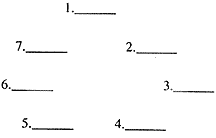|
2nd Grade Performance Task
Developed for Texas Essential Knowledge and Skills (TEKS)
Authors: Betty Crocker, Janette Fentress, Virginia Malone, Theresa
Weeks
Description:
Students observe water changing from a liquid to a
gas during evaporation.
Students will create a model to explore the water
cycle.
This task is designed to take approximately 20 minutes.
Overall Task Content Area:
-
Earth Science
Specific Knowledge Areas:
-
Water Cycle
Performance Expectations:
- collecting data by observing the evaporation of water from a
cup over a 3-5 day period
National Science Education Standards:
4 AS I 1: Communicate investigations
and explanations. Grades K-4
1.5 Students should begin developing the abilities
to communicate, critique, and analyze their work and the work of
other students. This communication might be spoken or drawn as well
as written.
8 D ESS 1: Structure of the earth system.
Grades 5-8
8DESS1.6 Water, which covers the majority of the earth’s surface,
circulates through the crust, oceans, and atmosphere in what is
known as the "water cycle." Water evaporates from the
earth’s surface, rises and cools as it moves to higher elevations,
condenses as rain or snow, and falls to the surface where it collects
in lakes, oceans, soil, and in rocks underground.
National Council of Teachers of Mathematics:
DAP 1:Formulate questions that can be addressed
with data and collect, organize, and display relevant data to answer
them.
Grade 6-8 e. collect data using observations, surveys,
and experiments
Grade 6-8 f. represent data using tables and
graphs such as line plots, bar graphs, and line graphs
General Instructions to the Teacher:
This task is designed to take students approximately
1 class period of 20 minutes.
Students will be working both individually and in
groups during this exercise.
Students should be ready to work as soon as the period
begins. The materials should be set out at each lab station, if
possible. A central supply area, if needed, should be easily accessible.
All supplies should be clearly labeled.
Materials for "Up, Up, and Away":
At each station students should have:
- Damp sponge
- Container of water
- Clear plastic clear plastic cups for small groups (2-4 students)
- Permanent marker to write on the clear plastic cups
- Water journals
- Sentence strips showing each line of the Water Rhyme
Advance Preparation:
Locate places where clear plastics cups of water can be stored
for evaporation to occur. The location should be light, warm, or
air currents but not be in a high traffic area. List these sites
on a chart for student references.
Students may also add additional sites to the chart. Prepare sentence
strips, charts or overhead transparencies showing one line at a
time of the Water Rhyme. Use each line as called for and repeat
all preceding verses as you work through the water cycle. Place
the sentences so at the end they will form a circle.

- Water, water, will you stay or find a way?
- Water, water, went away, found a place to hide away.
- Water, water hide away, collect as droplets where you stay.
- Water, water droplets play, become clouds without delay.
- Water, water clouds are growing, now we find your rain is showing.
- Water, water, circle away, come as rain another day.
- Water, water, reappear, keep the circle going here.
Teacher Talk: Use the rhythm pattern of "Rain,
rain, go away, come again some other day" for the Water Rhyme.
Safety:
- Be careful.
- Teachers and students should always exercise appropriate safety
precautions and utilize appropriate laboratory safety procedures
and equipment when working on science performance tasks.
Extensions/modifications:
- "Up, Up, & Away," is one part of a five part assessment
that was administered.The other four stations are "Do You
See What I See" "Here It Comes Again," "Here
Comes the Rain," and "The Rainmaker."
- Ask students to determine the amount of water lost each day
and graph the amounts.
|


